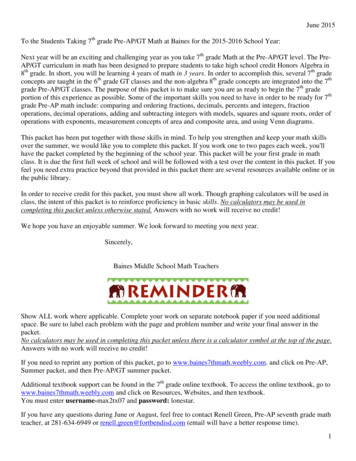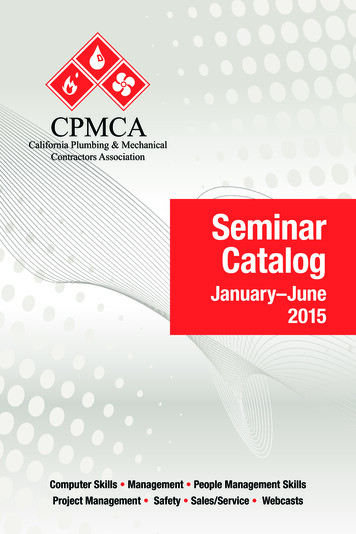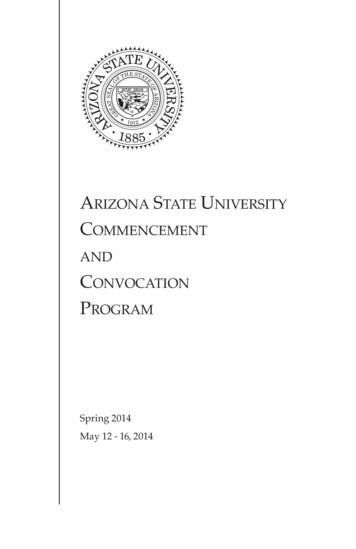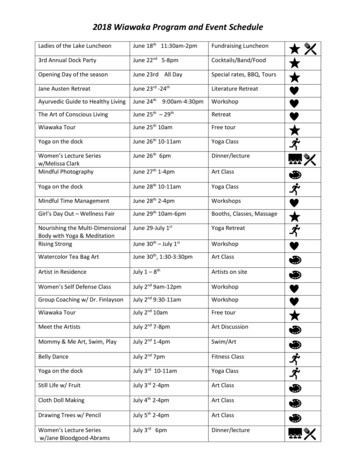
Transcription
June 2015To the Students Taking 7th grade Pre-AP/GT Math at Baines for the 2015-2016 School Year:Next year will be an exciting and challenging year as you take 7th grade Math at the Pre-AP/GT level. The PreAP/GT curriculum in math has been designed to prepare students to take high school credit Honors Algebra in8th grade. In short, you will be learning 4 years of math in 3 years. In order to accomplish this, several 7th gradeconcepts are taught in the 6th grade GT classes and the non-algebra 8th grade concepts are integrated into the 7thgrade Pre-AP/GT classes. The purpose of this packet is to make sure you are as ready to begin the 7th gradeportion of this experience as possible. Some of the important skills you need to have in order to be ready for 7thgrade Pre-AP math include: comparing and ordering fractions, decimals, percents and integers, fractionoperations, decimal operations, adding and subtracting integers with models, squares and square roots, order ofoperations with exponents, measurement concepts of area and composite area, and using Venn diagrams.This packet has been put together with those skills in mind. To help you strengthen and keep your math skillsover the summer, we would like you to complete this packet. If you work one to two pages each week, you'llhave the packet completed by the beginning of the school year. This packet will be your first grade in mathclass. It is due the first full week of school and will be followed with a test over the content in this packet. If youfeel you need extra practice beyond that provided in this packet there are several resources available online or inthe public library.In order to receive credit for this packet, you must show all work. Though graphing calculators will be used inclass, the intent of this packet is to reinforce proficiency in basic skills. No calculators may be used incompleting this packet unless otherwise stated. Answers with no work will receive no credit!We hope you have an enjoyable summer. We look forward to meeting you next year.Sincerely,Baines Middle School Math TeachersShow ALL work where applicable. Complete your work on separate notebook paper if you need additionalspace. Be sure to label each problem with the page and problem number and write your final answer in thepacket.No calculators may be used in completing this packet unless there is a calculator symbol at the top of the page.Answers with no work will receive no credit!If you need to reprint any portion of this packet, go to www.baines7thmath.weebly.com. and click on Pre-AP,Summer packet, and then Pre-AP/GT summer packet.Additional textbook support can be found in the 7th grade online textbook. To access the online textbook, go towww.baines7thmath.weebly.com and click on Resources, Websites, and then textbook.You must enter username-max2tx07 and password: lonestar.If you have any questions during June or August, feel free to contact Renell Green, Pre-AP seventh grade mathteacher, at 281-634-6949 or renell.green@fortbendisd.com (email will have a better response time).1
Objective: Converting fractions, decimals, and percents. To write a decimal as a fraction, divide the numerator of the fraction by the denominator. To change a decimal to a fraction, read the fraction mathematically correct identifying theplace value. Decimals and fractions that have a denominator that is a power of 10 (10, 100,1000, etc.) are read exactly the same.31o 0.31 are equivalent and are both read “thirty-one hundredths.”100To write a fraction as a percent, find an equivalent fraction with a denominator of 100.Instead of writing the denominator of 100, write the value in the numerator with a percentsign.416o 16%25 100 To write a percent as a fraction, write the percent (without the percent sign) as thenumerator and 100 as the denominator. Percent means “per 100.” To write a percent as a decimal, divide the percent by 100 and remove the percent sign. To write a decimal as a percent, multiply the decimal by 100 and add the percent symbol.Convert each of the following values to fractions in simplest form.1. 0.84. 2.257. 70%2. 0.525. 15%8. 135%3. 0.866. 95%9. 1%Convert each of the following values to decimals.510. 21%13. 181911.14. 7%20112. 10 %215. 345Convert each of the following values to percents.719. 0.0622.20720.23. 0.2471021. 0.6624.175016.235017. 734%18. 0.5%25. 0.760126.1827. 5.91Glencoe Grade 7 online textbook – reference chapter 5, sections 5, 6, and 7 and chapter 7, section 7.2
Objective: Compare and Order fractions, decimals, percents, and integers To compare fractions, decimals, percents and integers, rewrite all numbers so that theyare in the same form. For example, if the values are decimals and fractions, rewrite all ofthe values as decimals and compare. To compare fractions, rewrite them so they have common denominators. Another way to compare fractions is to express them as decimals. Then compare thedecimals.Fill in each blank with , , or to make a true sentence.1.45544. 0.3 0.337222. 3 3.255. -3 -53. 250%26. 36%38Order each set of values from least to greatest.7. 0.48, 0.46,8.9209. 99%,113, 23%, 0.4, 0.2,45097, 0.89, , 1.18810. 15 F, -7 F, 32 F, -15 F, -2 F, -27 F11. The following depths or heights are relative to sea level. List the order of the locationsfrom highest to lowest.LocationDepth or Height (m)Calipatria, CaliforniaMount EverestMariana TrenchMount McKinley, AlaskaLake Superior-568,848-10,9166,194-406Glencoe online textbook – reference chapter 5, section 9 and chapter 2, section 2.3
Objective: Add and Subtract Fractions Like fractions are fractions that have the same denominator. To add or subtract likefractions, add or subtract the numerators and write the result over the denominator. Simplify if necessary. To add or subtract unlike fractions, rename the fractions with a least commondenominator. Then add or subtract as with like fractions. To add or subtract mixed numbers:o Add or subtract the fractions. Rename using common denominators if necessary.o Add or subtract the whole numbers.o Simplify if necessary.5Example: Find 21 12 .8Add or subtract. Write in simplest form.1.93 10 107. a b if a 53and b .6813. 477 216122.5 2 9 98. a – b if a 53and b .6814. 832 3453.8 1 15 59.4.4 1 9 123110. 9 2555.7 2 9 311. 36.53 12 102112. 15 73593 b if b .10833 544Glencoe online textbook – reference chapter 6, sections 2 and 3.15. 8 316. 72577 69817. 10311 781218. 12131 41594
Objective: Multiply fractions and mixed numbers.Multiply. Write in simplest form. Include the model for #s 1, 2, 4, and 8.3 31 42 71.8.15. 2 1 5 72 53 92.1 3 9 59.9 26 13 274 116. 2 5 33.15 3 24 2010.4 594417. 1 2974.1 1 7 511. 7 275318. 5 6865.5 14 7 151 112. 4 2 37119. 10 4496.9 5 10 9313. 5 1247320. 9 7497.4 3 11 814. 14 23721. 3.75 2Glencoe online textbook – reference chapter 6, section 5.475
Objective: Dividing fractions and mixed numbers.Divide. Write answer in simplest form.2 12 51.6. 3 45 62. 5 3.1215 326244. 5 1555. 436 2777.11.5 1088. 36 19. 61 1 2 5112. 7 2312113. 2 10221 33914. 21 3 4 81215. 411 36610. 12 2Glencoe online textbook – reference chapter 6, section 6.6
Objective: Multiplying DecimalsMultiply.1. 4.1 76. 0.76 4.111. 0.21 4.232. 3 2.97. 1.72 612. 6.23 0.113. 6.8 78. 0.34 1.4813. 1.65 1.384. 3.15 0.39. 6.46 0.9114. 0.51 4.015. 8.21 410. 2.93 1.0715. 12.57 2.63Glencoe online textbook – reference chapter 3, section 27
Objective: Dividing DecimalsDivide. Round the answer to three decimal places if necessary.1. 9.2 36. 11.2 811. 0.091 62. 18.73 97. 0.438 712. 15.61 83. 0.07 48. 17.562 1113. 0.23 34. 21.97 69. 25.03 314. 8.69 95. 6.04 210. 5.38 815. 20.983 5Glencoe online textbook – reference chapter 3, section 48
Objective: Exponents, Squares, and Square Roots The exponent tells you how many times the base is used as a factor.o To write 63 as a product of the same factor, 6 is used as a factor 3 times.63 6 6 6o To evaluate 54, find the product of 5 5 5 5 . So, 54 625.o To write 4 4 4 4 4 4 in exponential form, write the base and count the commonfactors. The number of common factors is the exponent. So, 4 4 4 4 4 4 46. The product of a number and itself is the square of the number.o The square of 5 is 25 because 5 * 5 25. The factors multiplied to form perfect squares are called square roots.o Both 7 7 and ( 7)( 7) equal 49. So 49 has two square roots, 7 and -7.o A radical sign, , is the symbol used to indicate the positive square root of anumber. So 49 7.Write each power as a product of the same factor.1. 253. 1745. 732. 164. 376. 86Evaluate each expression.7. 269. 4711. 1048. 6210. 1912. 34Write each product in exponential form.15. 4 4 4 413. 12 1217. 15 15 15 15 1514. 10 10 1018. 6 6 6 6 6 6 6 616. 9 9 9 9 9 9 9Find the square of each number.19. 321. 2523. 920. 2222. 4024. 14Find each square root.25. 2527.44129.3,60026.28.90030.8110031. What is the square of -37?32. Find both square roots of 64.33. Square 7.2.34. Square 4.5.9Glencoe online textbook – reference chapter 1, sections 2 and 3.
Objective: Order of OperationsUse the order of operations to evaluate numerical expressions.1. Do all operations within grouping symbols ( ) first.2. Evaluate all powers before other operations.3. Multiply and divide in order from lest to right.4. Add and subtract in order from left to right.Example: Evaluate 8 (1 5) 2 4.First, add 1 and 5 inside the parenthesis (grouping symbols.)8 62 4Find the value of 628 36 4Divide 36 by 4.8 917Add 8 and 9.Evaluate each expression.1. 9 – 3 49. (4 2) (7 4)17. 5 4 2 3 22. 12 4 510. (3 18) (2 9)18. 13 (6 5) 53. 25 2 711. 24 6 4 219. (11 4 10) 212. 3 8 (9 7) 320. 10 2 (4 3)13. 9 (9 8 3) 421. 1.82 10 514. 3 2 2 24 822. 35 7 2 415. (15 3) 2 9 323. 2 5 7(9 1)16. (52 4) 5 324. 12 16 (3 1)4. 36 9(2)5. 6 3(7 2)6. 3 6.2 5 27. (1 11) 2 38. 15 24 4 2Glencoe online textbook – reference chapter 1, section 410
Objective: Adding Integers with ModelsTo add integers, it is helpful to use a model. When using counters, first draw circles or squares to represent the problem.o To represent a positive unit, draw a small un-shaded circle or square.o To represent a negative unit, draw a small shaded circle or square. Line up negatives and positives so that you can circle “zero pairs.”o ( 1) (-1) 0. We call a positive tile a negative tile a zero pair. “Remove” all zero pairs by either drawing an “X” through them or drawing an arrow. The remaining tiles are the answer.Draw counters or a number line to find the sum of each expression.7. 15 (-10)4. -7 (-7)1. 5 (-8)2. -3 35. -8 108. -11 (-12)3. -3 (-8)6. -7 139. -14 (-13)Evaluate each expression if a -8 and b -4. Draw counters or a number line to findthe sum of each expression.10. 5 a12. a b14. a (-7)11. b (-9)13. 12 b15. a 011Glencoe online textbook – reference chapter 2, section 4.
Objective: Subtracting Integers with Models When using counters to subtract, first draw circles or squares to represent the firstnumber in the subtraction problem.o To represent a positive unit, draw a small un-shaded circle or square.o To represent a negative unit, draw a small shaded circle or square. Look at the second number and “take away” that many tiles by circling the tiles anddrawing an arrow. IF there are not enough tiles, you must add zero pairs until you have enough of the tilesyou need to take away. By adding zero pairs, you are not changing the value of theoriginal number. The remaining tiles are the answer.Example 1: Find -5 – (-2).Example 2: Find -3 – 2.1. Draw 5 negative tiles.1. Draw 3 negative tiles.2. Circle and “take away” 2 negative tiles.2. You can not remove 2 positive tiles soadd two zero pairs.3. Now you can remove 2 positive tiles.3. There are 3 negative tiles left,so -5 – (-2) -3There are 5 negative tiles left so -3 – 2 -5Subtract. Draw counters to find the difference of each expression.1. 5 – 24. 8 – 137. -3 – 82. 6 – (-7)5. -7 – (-7)8. 10 – 123. 3 – (-2)6. 6 – 119. -8 – (-3)Evaluate each expression if r -4 and s 10 and t -7.10. r – 712. s – (-8)11. t – s13. t – rGlencoe online textbook – reference Chapter 2, section 514. s – t15. r – s12
13
14
Objective: Measurement – Area and Composite Area Complex figures are made of two-dimensional figures.To find the area of a complex figure, separate it into figures whose areas you know how tofind, and then add the areas. A formula chart can be found at the following link by clickingon Grade 7 Mathematics Chart. /If a piece appears to be “missing,” you would subtract the area of that piece.Find the area of each figure. Use π 3.14. Round the answer to the nearest tenthsplace if necessary. Be sure to label your answers with appropriate units.6.7 mm13.5 in.Find the perimeter of #1, 2, 4, and 5. For #1 and #5, use π nearest tenths place if necessary. Be sure to label units.1.2.22. Round all answers to the74.Glencoe online textbook – reference chapter 12, section 6.5.15
Objective: Statistics – Venn DiagramsA Venn diagram is an arrangement of overlapping circles used to show how sets of data arerelated.Draw a Venn diagram to show how the sets of data are related.1.2.3.4.16Glencoe online textbook – reference chapter 9, section 5
June 2015 . To the Students Taking 7th grade Pre-AP/GT Math at Baines for the 2015-2016 School Year: . Next year will be an exciting and challenging year as you take 7th grade Math at the Pre-AP/GT level. The Pre-AP/GT curriculum in math has been designed to prep










